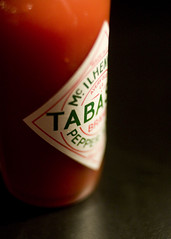On the occasion of me attending this week's episode of the Norwegian popsci TV series "Schrödingers katt" (and YouTube) about miracle fruit I'll post two entries on miracle fruit/miraculin. The first is a reposting on a previous entry, expanded with a few more tasting notes. The second post will be a collection of facts about miracle fruit including references to primary literature. Part 1:2 follows below.
The following entry was previously published 7 August 2010, slightly revised.
Note: the original blog entry has some interesting comments worth having a look at.
For some time now, there has been somewhat of a hype about the miraculous berry that makes everything sour taste sweet. Some time ago, I ordered a packet of dried and powdered miracle fruit tablets and gave it a try. The following post gives some background and the results of a truly fascinating experience.
The miracle fruit is a a berry containing the glycoprotein miraculin with the unlikely effect that when your taste buds meet this substance, you taste sour foods as they were sweet. That is, your perception of sourness is altered. In certain parts of the world, the substance has been used for quite long, whereas in USA and Europe it has not yet been cleared for use as additive. The berry in itself is allowed, but unfortunately they don't keep for long and are apparently not suited for shipping fresh. However, a freeze dried version made into tablets does exist and this is the version I tried.

There is quite some amount of research on the effect and mechanism of miraculin on our tongue as a google scholar search for "miraculin" reveals. The first scientific report was in Nature as early as in 1968 (correction: first time published in 1965). There is also research indicating that other plants exhibit similar effects, such as curculin from the Curculigo latifolia plant. The miraculin protein structure shown here is taken from the Swiss protein structure homology-modeling service.*
An ordinary google search gives various producers and web shops for buying the stuff. Adding to the fun are the conspiration theory-like suggestions (two refs.) of the sugar industry's ways of stopping miraculin approval in the USA since the product might reduce the population's consumption of sugar (which of course is beneficial for everyone except the sugar industry). There are also efforts being made on producing the miraculin glycoprotein using genetic engineering methods, and I guess the hope is that one might efficiently produce miraculin or a relative using common plants or organisms such as lettuce or E-coli bacteria (same as is done with production of other proteins/enzymes such as medicinal insulin or rennet for cheesemaking).
How does it work (in practice)?
Just pop a tablet of freeze dried miracle fruit in your mouth, let it roll arond until dissolved. It takes about a minute or two and tastes not very much. Rather flavour-/tasteless with some green flavours, tastes somewhat "healthy" if you know what I mean.
And what about the effect?
The effect is remarkable upon tasting various foods subsequent to eating the tablet. The effect lasts for about half an hour.
My sensory impression is that it alters the tongue's sensations, making sour taste sweet. That is, it does not suppress acid/sour taste, but part of the sour taste is converted to sweetness. The sweetness is rather sugary in character. However, some of the sour perception is still there, leaving part of the bite/freshness. It is almost like 70-80 % of the sour is converted to sweet, or somewhat like adding a lot of sugar to the food. In my experience, bitterness is not reduced, as claimed by one of the retailers (see tasting notes below).
The problems might arise later on, however, when you realise how much acidic food you have been swallowing... Below follows a long list of foods and how I felt it tasted (before and) after having the "miracle pill". You'll also find some relevant blog posts and research references if you scroll past the list.
|
| Apple juice Like sweetened apple squash. Very sweet, too sweet for my taste. Rather cloying. |
| Pure ascorbic acid Before: intensely sour/sharp. Sour taste overpowers almost every other conceivable flavour. After: Slightly bitter, resembling sherbet powder. I makes pure ascorbic acid edible (although I wouldn't guarantee any positive health effect, rather the opposite)! | |
Balsamic vinegar (inexpensive type) Before: rather acid and far from complex. After: Sweeter and more mellow. Resembles me of balsamico vinegar reduction without the syrupy texture/consistency (not as viscous as a reduction). Takes the vinegar one notch up in terms of flavour. | |
| Buttermilk Tastes like substantial amount of sugar is added. Well rounded flavour. Like sweetened youghurt but with the tartness and flavour of buttermilk, which is somewhat different from the one you get from youghurt culture. If you like cultured milk products with sugar you'll probably really like this one. | |
| Grapefruit Before: slightly sweet, bitter, a little sour/tart. After: really sweet with almost no sourness left. The bitterness remains unaltered. | |
 | Grapes Before: Medium sweet, somewhat tannic from the skins. After: Very sweet, but with the acidic bite still present. Doesn't taste sour, but still feels fresh (in a way, the acidity is noticeable without being tasted). |
 | Lemon Before: Lemony flavour, but very sour/sharp. Acidity is overpowering. After: Sweet and lemony, like lots of sugar has been added. The acidic bite is present, but perfectly edible as it is. Pleasant. |
 | Lime Before: Lime flavour, but rather sour/sharp. Acidity still overpowering, but less than for the lemon. After: Sweet and rich lime flavour, like lots of sugar has been added. Still has the acidic bite, but perfectly edible as it is. Very pleasant. |
 | Mango Before: Good, but with marked acidity. Acidity remains on the back of the tongue after swallowing. After: same as grape |
| Orange juice Resembles me of sweetened orange squash. Too sweet for my taste. | |
 | "Sour feet" sweets Before: sweet but at the same time rather tart. After: rather similar to before, but sweeter. The acidic bite is less pronounced (or even lacking) |
 | Tomato Does become markedly sweeter and full-bodied, the flavour resembles tomatoes being more ripe. On another occasion (on Scrödinger) the tomatoes tasted like they were sprinkled with sugar |
| Tonic water Before: Sweet, a little sour and bitter. Bitterness on the back of the tongue lingers a little. After: More neutral and sweet, but the bitterness remains. | |
|
| White- and red wine vinegar Before: both very sour/sharp. The acidity overpowers most flavours when taken pure. After, white: Like wine gone off. Sweet n'sour, flavour of ferment. Not pleasant at all. Quite revealing since off-/poor tastes is not longer overpowered by the acidity. After, red: Like white, but even less pleasant. Unpleasant aroma and flavour. |
|
| Coffee (Solberg & Hansen, "Black coffee") Before: Black coffee is a rather fruity Brasilian with marked natural acidity (a deliberate choice to enhance the effect of the miracle fruit). After: Very much like coffee with added sugar. In my opinion, the coffee was ruined, and I guess coffees with less acidity would taste less sweet as well. Initially I had very limited faith in this one when it comes to benefit from miracle fruit, ...and rightly so. I hereby apologise to the coffee makers for such an abuse of excellent coffee. |
| Tabasco (classic red) Before: Acidic, pungent, burning sensation lingering in the mouth and around the lips. After: Sweeter, still somewhat fruity and still just as pungent and burning. | |
|
| Dark chocolate (Freia 70% premium) Before: A little acidic and bitter. A typical 70% cocoa variety. After: Little difference. The idea was that dark, more acidic chocolate might require less sugar using miracle fruit. In this case, the difference was almost not noticeable. |
| Dry white wine Before: A standard dry table wine. After: Sweetish, somewhat cloying, freshness very much reduced. Really not good at all. |
Blogposts on miraculin/miracle fruit
- Cooking issues: A nice posting on miraculing and gymnemic acid (something of an opposite of miraculin)
- notcot.com: tasting using fresh miracle fruit/berries
- taffel.se: well researched post in Swedish ("Anti-syratripp: Mirakulin ger kick åt matnördar")
- khymos: short posting on miracle fruit
Selected scientific papers
Inglett et al. (1965). Taste Modifiers, Taste-Modifying Properties of Miracle Fruit (Synsepalum Dulcificum). J. Agric. Food Chem., 13(3), 284-287
Brouwer et al. (1968). Miraculin, the Sweetness-inducing Protein from Miracle Fruit. Nature 220, 373-374.
Brouwer et al. (1968). Miraculin, the Sweetness-inducing Protein from Miracle Fruit. Nature 220, 373-374.
Theerasilp et al. (1989). Complete amino acid sequence and structure characterization of the taste-modifying protein, miraculin. J. Biol. Chem., 264, 6655-6659. (open access paper + "fellow 1988 article")
Paladino et al. (2008). Molecular modelling of miraculin: Structural analyses and functional hypotheses. Biochem. Biophys. Res. Comm., 367(1), 26-32.
*Appropriate references to Swiss-model protein structure
Kiefer F, Arnold K, Künzli M, Bordoli L, Schwede T (2009). The SWISS-MODEL Repository and associated resources. Nucleic Acids Res. 37, D387-D392.
Jürgen Kopp and Torsten Schwede (2004). The SWISS-MODEL Repository of annotated three-dimensional protein structure homology models. Nucleic Acids Res. 32, D230-D234.














No comments:
Post a Comment
Please add your comments